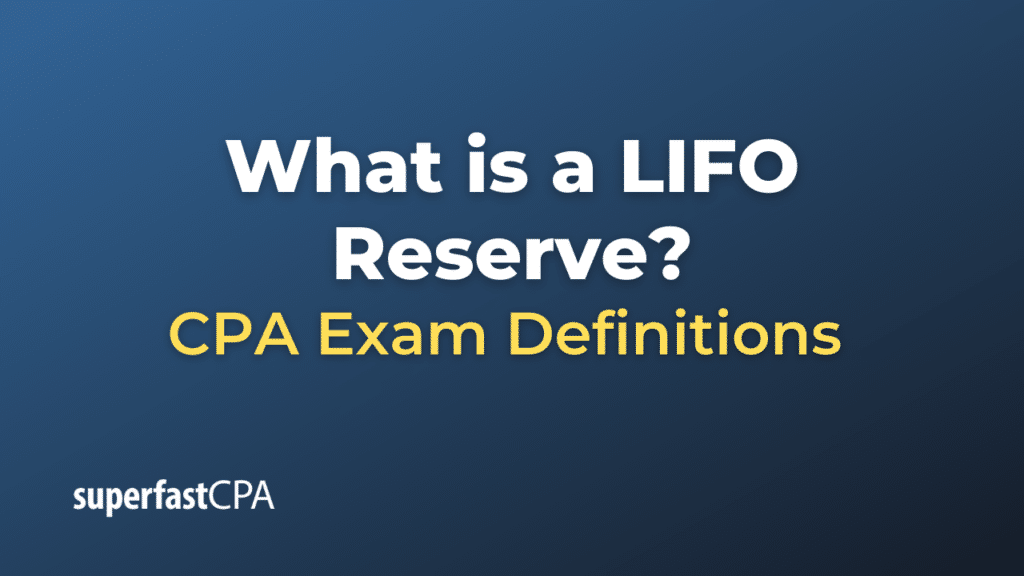LIFO Reserve
The LIFO (Last-In, First-Out) Reserve is an accounting term used to bridge the gap between LIFO and FIFO (First-In, First-Out) inventory methods.
LIFO and FIFO are inventory valuation methods.
- Under FIFO, it is assumed that the oldest inventory items are sold first. This might be a good reflection of the actual flow of inventory for certain types of businesses, for instance, those dealing with perishable goods.
- LIFO, on the other hand, assumes that the most recently acquired (last in) inventory is the first to be sold.
The choice between LIFO and FIFO can have significant effects on reported profits and tax liability, due to changes in the cost of inventory over time.
LIFO Reserve is an account used to adjust the company’s inventory to show what it would be under the FIFO method. It is calculated as the difference between the cost of inventory calculated using the LIFO method and the cost of inventory using the FIFO method.
If the cost of inventory rises over time (inflationary environment), then the LIFO method will typically result in a higher cost of goods sold (COGS) and lower profits, thus less tax. The LIFO Reserve in this scenario will be a positive amount, since FIFO inventory is higher than LIFO inventory.
If costs of inventory are falling, however, the LIFO method will typically result in lower COGS and higher profits, thus higher tax. The LIFO Reserve in this scenario will be a negative amount, as LIFO inventory is higher than FIFO inventory.
The LIFO Reserve helps analysts and investors compare companies that use different inventory accounting methods. By adding the LIFO reserve to the LIFO-based inventory, one can estimate what the inventory would be under FIFO.
Example of a LIFO Reserve
Let’s imagine a simple example of a company that sells a single type of product. This company buys and sells 1,000 units each year. Here’s what the prices look like over three years:
- Year 1: The company buys 1,000 units at $10 each, so the total cost is $10,000.
- Year 2: The company buys 1,000 units at $12 each, so the total cost is $12,000.
- Year 3: The company buys 1,000 units at $15 each, so the total cost is $15,000.
Now, let’s consider the cost of goods sold (COGS) and the ending inventory for this company under both LIFO and FIFO at the end of Year 3.
Under LIFO:
- The COGS each year would be the cost of the units bought that year, as it assumes the latest goods bought are sold first. So, the total COGS over three years would be $10,000 (Year 1) + $12,000 (Year 2) + $15,000 (Year 3) = $37,000.
- The ending inventory would be zero, as all goods are assumed to be sold each year under LIFO.
Under FIFO:
- The COGS for Year 1 would be $10,000, for Year 2 it would still be $10,000 (as it’s assumed that the items bought in Year 1 are sold in Year 2), and for Year 3 it would be $12,000 (assuming items bought in Year 2 are sold). So, the total COGS under FIFO would be $10,000 (Year 1) + $10,000 (Year 2) + $12,000 (Year 3) = $32,000.
- The ending inventory under FIFO would be the 1,000 units bought in Year 3 which are assumed not to be sold yet, so $15,000.
Now, we can calculate the LIFO reserve at the end of Year 3. It’s the difference between the FIFO ending inventory and the LIFO ending inventory: $15,000 (FIFO) – $0 (LIFO) = $15,000. So, the LIFO Reserve in this case would be $15,000.
This LIFO reserve represents the additional inventory value that would have been reported if the company had used FIFO instead of LIFO. It also indicates the amount of deferred taxable income due to using the LIFO method.













